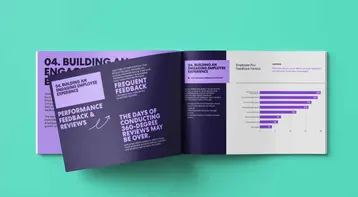How AI Can Be Leveraged to Support HR Departments

Table of contents
- 1.Recruitment
- 2.Employee Onboarding
- 3.Employee Engagement and Retention
- 4.Performance Management
- 5.HR Operations
- 6.Diversity, Equity, and Inclusion
- 7.Employee Well-being
- 8.Artificial Intelligence in Human Resources: Real-World Applications and Examples
- 9.Recruitment:
- 10.Employee Onboarding:
- 11.Employee Engagement and Retention:
- 12.Performance Management:
- 13.HR Operations:
Artificial intelligence (AI) has become a hot topic in nearly every industry and for good reason—the potential for efficiency and cost-savings while taking menial or repetitive tasks off the plates of human workers can seem too potent to ignore. While the human touch will and should always be a key component in the world of human resources, there may be several different ways in which the use of powerful AI technologies can help support HR and HR teams.
Human resources departments can leverage AI in various ways to help streamline processes, enhance decision-making, and improve overall efficiency. Here are seven different ways in which HR departments can harness the power of AI.
1. Recruitment
AI can help support several important functions in the recruiting process, especially when there’s a large volume of job postings to sift through. Some of the potential applications for AI include:
- Resume screening: AI-powered tools can quickly scan through resumes to help identify candidates based on the company’s predefined criteria.
- Candidate sourcing: AI algorithms can help search through various platforms to identify potential candidates who may match specific job requirements.
- Candidate matching: AI can help match candidate profiles with job descriptions, helping recruiters find the best-fit candidates more efficiently.
- Chatbots for initial screening: AI-driven chatbots can help engage with candidates, ask preliminary questions, and provide information about the company and job roles.
2. Employee Onboarding
Employee onboarding or employee training may not be the first place you’d think AI can support HR, but it turns out that there are a few different places where there are advantages, such as:
- Personalized onboarding: AI can help customize onboarding processes based on the employee’s needs, roles and skill levels.
- Training and development: AI-driven learning platforms can deliver personalized training content and recommend courses based on employee’s functions, performance and career goals.
3. Employee Engagement and Retention
AI can often take advantage of large datasets, combing through information and identifying relevant information to bring to the attention of stakeholders. When it comes to employee retention and engagement, there are several ways that AI can be put to use today:
- Pulse surveys: AI can analyze employee sentiment through pulse surveys, feedback forms and social media to gauge engagement levels.
- Predictive analytics: AI algorithms can give a prediction of which employees may be at risk of leaving based on various factors like performance, engagement and tenure, allowing HR to take proactive measures to retain talent.
- Recommendation systems: AI can suggest personalized career development opportunities, projects or internal job openings to employees based on their skills and interests.
4. Performance Management
Ongoing performance management is a crucial piece to maximizing the effectiveness of a workforce. When businesses use AI to support performance management, there are a few places that provide initial opportunities:
- Continuous feedback: AI-powered platforms can help facilitate continuous feedback loops by collecting feedback from multiple sources and providing actionable insights to employees and managers.
- Performance reviews: AI can assist in evaluating employee performance by analyzing data from various sources, such as project outcomes, customer feedback and peer reviews.
5. HR Operations
Getting administrative work off the hands of your valued HR team can free up time for them to focus on other priorities while promoting efficiency. Two different places that AI can be leveraged to help in HR operations include:
- Automated administrative tasks: AI can help automate repetitive administrative tasks involved in payroll processing, scheduling interviews and managing leave requests, freeing up HR professionals to focus on strategic initiatives.
- Compliance support and risk mitigation: AI can help support compliance with labor laws and company policies by flagging potential violations and providing recommendations for corrective actions.
6. Diversity, Equity, and Inclusion
Bias reduction: AI algorithms can help minimize unconscious bias in recruitment and performance evaluation processes by focusing on relevant criteria and removing demographic information from decision-making.
7. Employee Well-being
Mental health support: AI-driven chatbots and virtual assistants can help provide employees with resources and support for managing stress, helping to prevent burnout, maintaining work-life balance and accessing mental health services.
It's important for HR departments to implement AI ethically, ensuring transparency, fairness and accountability throughout the process to maintain trust and avoid unintended consequences. While some AI tools can help reduce bias, there can also be bias in the training of its algorithms. Employers therefore must ensure that the AI does not introduce illegal bias into the process and must confirm that their AI tools comply with applicable laws, including those requiring regular audits for bias. Additionally, AI should complement human expertise rather than replace it entirely, allowing HR professionals to leverage technology to enhance their decision-making and strategic initiatives.
Artificial Intelligence in Human Resources: Real-World Applications and Examples
AI has emerged as a transformative tool for human resources departments, offering innovative solutions to help streamline processes, enhance decision-making and optimize workforce management. In this expanded discussion, we'll explore various ways HR departments can leverage AI, along with real-world examples and hypothetical scenarios to illustrate their applications.
Recruitment:
AI-powered tools have revolutionized the recruitment process, helping HR professionals to identify and attract top talent more efficiently.
Example 1: Resume Screening
AI algorithms can help analyze resumes to identify relevant skills, experiences and qualifications, allowing recruiters to shortlist candidates quickly. For instance, a recruitment platform powered by AI may screen resumes for a software engineering position, highlighting candidates with specific programming languages and project experience as required by the job description.
Example 2: Candidate Sourcing
AI-driven sourcing tools can help search through vast databases of job seekers to identify potential candidates who match specific criteria. Imagine an AI-powered talent acquisition platform that scours professional networking sites, such as LinkedIn, to find candidates with the desired skills and job titles for a marketing manager role.
Employee Onboarding:
AI can help personalize the onboarding experience for new hires, ensuring a smoother transition into the organization.
Example 1: Personalized Onboarding Plans
An AI-driven onboarding platform can help create customized onboarding plans based on new hires' roles, departments and preferences. For instance, an entry-level sales associate may receive a tailored onboarding plan that includes training modules on sales techniques, product knowledge and CRM software usage.
Example 2: Adaptive Learning Programs
AI-powered learning platforms can deliver adaptive training content based on employees' skill levels and learning styles. Consider a scenario where a new employee joins a customer service team. The AI system assesses their existing knowledge and tailors training materials accordingly, focusing on areas where additional support is needed.
Employee Engagement and Retention:
AI can help HR departments measure employee engagement, predict turnover risks and implement strategies to improve retention rates.
Example 1: Pulse Surveys and Sentiment Analysis
AI-powered survey tools can help collect real-time feedback from employees and analyze sentiment to gauge overall engagement levels. Imagine that an organization conducts monthly pulse surveys using an AI platform that employs natural language processing (NLP) to analyze responses; the HR team can identify trends, such as declining morale in a particular department, and take proactive measures to address concerns.
Example 2: Predictive Analytics for Turnover
AI algorithms can help analyze various data points, such as employee performance, tenure and demographics, which may predict turnover risks. An example could be an HR dashboard powered by AI that provides insights into employees who are at high risk of leaving the company based on historical patterns and current indicators. Armed with this information, HR can implement targeted retention strategies, such as career development opportunities or flexible work arrangements.
Performance Management:
AI-driven solutions can help facilitate continuous feedback, performance evaluations and skill development initiatives.
Example 1: Continuous Feedback Loops
AI-powered feedback platforms enable managers and peers to provide real-time feedback to employees throughout the year. For example, an AI-driven feedback tool integrated into a project management system allows team members to offer constructive feedback on tasks and deliverables as they occur, fostering a culture of continuous improvement.
Example 2: Objective Performance Reviews
AI algorithms can assist HR professionals in conducting more objective performance evaluations by analyzing quantifiable metrics and removing bias. Performance review systems powered by AI may be able to evaluate sales performance based on objective metrics such as revenue generated, customer satisfaction scores and quota attainment, reducing the influence of subjective factors.
HR Operations:
AI provides the capacity to help complete administrative tasks, streamline workflows and enhance operational efficiency within HR departments.
Example 1: Automated Administrative Processes
AI-powered chatbots and virtual assistants can help handle routine inquiries from employees regarding HR policies, benefits and leave requests. If an employee needs to update their personal information in the HR system, instead of submitting a manual request, they interact with an AI chatbot that guides them through the process in real time, saving both time and resources.
Example 2: Predictive Analytics for Workforce Planning
AI algorithms can help analyze workforce data to forecast future staffing needs, identify skill gaps and optimize resource allocation. Leveraging AI, an HR analytics dashboard might use machine learning models to predict fluctuations in demand for certain job roles based on historical trends, allowing HR teams to proactively recruit or train employees to meet future needs.
In conclusion, AI offers immense potential for revolutionizing human resources functions across recruitment, onboarding, employee engagement, performance management and HR operations. By leveraging AI-driven tools and technologies, HR departments can enhance efficiency, drive employee satisfaction and contribute to organizational success in today's dynamic business landscape. As AI continues to evolve and grow, businesses should keep in mind, when using AI to help support their HR operations, they should use AI responsibly and ethically.
© 2024 TriNet Group, Inc. All rights reserved. This communication is for informational purposes only, is not legal, tax or accounting advice, and is not an offer to sell, buy or procure insurance.

TriNet Team
Table of contents
- 1.Recruitment
- 2.Employee Onboarding
- 3.Employee Engagement and Retention
- 4.Performance Management
- 5.HR Operations
- 6.Diversity, Equity, and Inclusion
- 7.Employee Well-being
- 8.Artificial Intelligence in Human Resources: Real-World Applications and Examples
- 9.Recruitment:
- 10.Employee Onboarding:
- 11.Employee Engagement and Retention:
- 12.Performance Management:
- 13.HR Operations:





